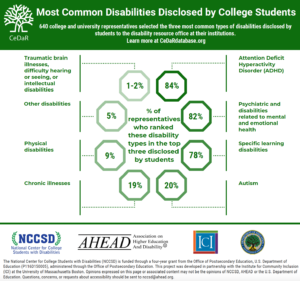Students with Disabilities in Higher Education
Learning Objectives
In this session, you will engage with colleagues to:
- Differentiate accessibility and accommodations and their impact on student learning
- Identify the types of disabilities most prevalent among college students
The Numbers
What do we know about students living with disabilities in our classes? In 2019-2020, 21% of undergraduate and 11% of graduate students reported have a disability (NCES 2023).[1] Of the types of disability reported, ADHD, learning disabilities, and mental health conditions were most prevalent. A survey of over 50,000 U.S. college students revealed that 35% of students reported having been diagnosed with anxiety and 27% with depression.[2] To learn more about types of disabilities, see Diverse Abilities and Barriers.

One problem is that these numbers capture only those students who report a disability to their Disability Services Office. According to a 2022 NCES report, about one-third of college students with disabilities self-disclose while in college.[3] The data available to us are an underestimate of the total number of students living with disabilities in our institutions.
Beyond the Numbers
Many students may be eligible for accommodations but do not seek them out due to a variety of reasons (stigma, lack of documentation, financial constraints, or they are unaware of the resources available to them). You may not be able to tell who those students are because the most prevalent forms of disability on college campuses are hidden/invisible disabilities (learning disabilities, ADHD, depression and anxiety, chronic illness, traumatic brain injury, etc.).
There are also faculty and staff with disabilities, as well as parents and caretakers. Our institutions serve not only our students, but our community. They provide jobs, resources, events, and opportunities for continued growth and education. Disability touches every population and is very likely to touch each of us at some point in our lives. Currently, the CDC reports that 1 in 4 adults in the U.S. lives with a disability.
Accessibility does not just benefit people with disabilities. Think of it this way: Elevators allow people unable to use the stairs to reach the different floors in a multi-story building. But does that mean you must be impaired to use the elevator? If someone is carrying a lot of items, or they are running late to a meeting on the 25th floor, then the elevator benefits them as well.
Accessible content and inclusive pedagogy work the same way. For example, a captioned video is not only helpful to someone who is deaf or hard of hearing, but it can help a person trying to watch the video in a noisy public space, or help someone for whom English is not their native language. Designing buildings, or digital content, or pedagogy, in such a way as to maximize use for the most people possible, is known as Universal Design.
Additional Resources
Text Attributions
- This chapter was adapted from SBCTC’s Library of Accessibility Resources. Licensed under a CC Attribution license.
- Table 311.10. Number and percentage distribution of students enrolled in postsecondary institutions, by level, disability status, and selected student characteristics: Academic year 2019–20 [Data table]. ↵
- American College Health Association. American College Health Association-National College Health Assessment III: Undergraduate Student Reference Group Data Report Spring 2022. Silver Spring, MD: American College Health Association; 2022. ↵
- Use of Supports Among Students With Disabilities and Special Needs in College. National Center for Education Statistics at Institute of Education Sciences. April 2022. ↵

